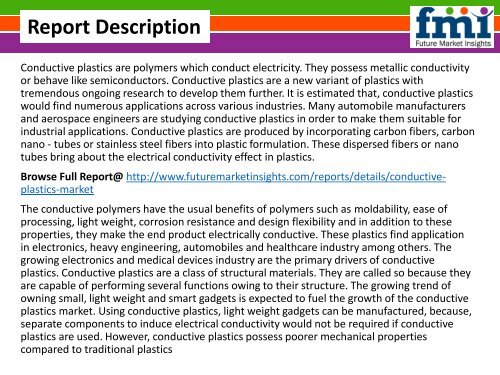Conductive Plastics Market – Global Industry Analysis and Opportunity Assessment 2014 - 2020: Future Market Insights
Conductive plastics are polymers which conduct electricity. They possess metallic conductivity or behave like semiconductors. Conductive plastics are a new variant of plastics with tremendous ongoing research to develop them further. It is estimated that, conductive plastics would find numerous applications across various industries. Many automobile manufacturers and aerospace engineers are studying conductive plastics in order to make them suitable for industrial applications. Conductive plastics are produced by incorporating carbon fibers, carbon nano - tubes or stainless steel fibers into plastic formulation. These dispersed fibers or nano tubes bring about the electrical conductivity effect in plastics.
Conductive plastics are polymers which conduct electricity. They possess metallic conductivity or behave like semiconductors. Conductive plastics are a new variant of plastics with tremendous ongoing research to develop them further. It is estimated that, conductive plastics would find numerous applications across various industries. Many automobile manufacturers and aerospace engineers are studying conductive plastics in order to make them suitable for industrial applications. Conductive plastics are produced by incorporating carbon fibers, carbon nano - tubes or stainless steel fibers into plastic formulation. These dispersed fibers or nano tubes bring about the electrical conductivity effect in plastics.
Create successful ePaper yourself
Turn your PDF publications into a flip-book with our unique Google optimized e-Paper software.
Report Description<br />
<strong>Conductive</strong> plastics are polymers which conduct electricity. They possess metallic conductivity<br />
or behave like semiconductors. <strong>Conductive</strong> plastics are a new variant of plastics with<br />
tremendous ongoing research to develop them further. It is estimated that, conductive plastics<br />
would find numerous applications across various industries. Many automobile manufacturers<br />
<strong>and</strong> aerospace engineers are studying conductive plastics in order to make them suitable for<br />
industrial applications. <strong>Conductive</strong> plastics are produced by incorporating carbon fibers, carbon<br />
nano - tubes or stainless steel fibers into plastic formulation. These dispersed fibers or nano<br />
tubes bring about the electrical conductivity effect in plastics.<br />
Browse Full Report@ http://www.futuremarketinsights.com/reports/details/conductiveplastics-market<br />
The conductive polymers have the usual benefits of polymers such as moldability, ease of<br />
processing, light weight, corrosion resistance <strong>and</strong> design flexibility <strong>and</strong> in addition to these<br />
properties, they make the end product electrically conductive. These plastics find application<br />
in electronics, heavy engineering, automobiles <strong>and</strong> healthcare industry among others. The<br />
growing electronics <strong>and</strong> medical devices industry are the primary drivers of conductive<br />
plastics. <strong>Conductive</strong> plastics are a class of structural materials. They are called so because they<br />
are capable of performing several functions owing to their structure. The growing trend of<br />
owning small, light weight <strong>and</strong> smart gadgets is expected to fuel the growth of the conductive<br />
plastics market. Using conductive plastics, light weight gadgets can be manufactured, because,<br />
separate components to induce electrical conductivity would not be required if conductive<br />
plastics are used. However, conductive plastics possess poorer mechanical properties<br />
compared to traditional plastics

















